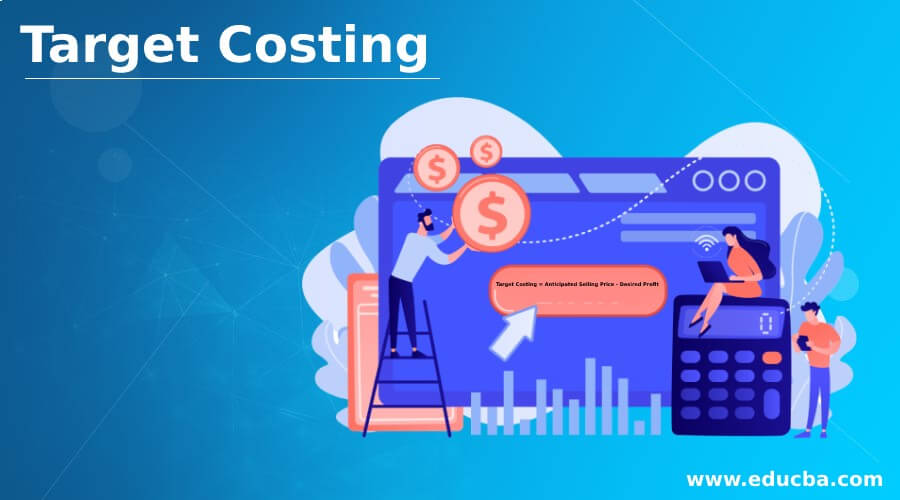Updated July 10, 2023
What is Target Costing?
The term “target costing” refers to the structured approach companies use to ascertain the cost at which the future product, given its functionality and quality, should be manufactured to generate the planned profitability at the anticipated selling price.
In other words, it is a management tool used to identify, anticipate and profitably cater to customer needs. Mathematically, the formula for target costing is expressed as the difference between the anticipated selling price and desired profit, as shown below,
Explanation
In competitive industries like construction, FMCG, energy, and healthcare, the producers have no control over their products’ selling price, as determined by market demand and supply. In such a scenario, the producers can only control the production cost, so the management focuses on each cost component. Consequently, the management uses the target costing technique for proactive cost planning. As a result, the cost of production planning and calculated early in the product development cycle.
Features of Target Costing
Some of the salient features are as follows:
- The producers are price takers as market conditions govern the product pricing.
- The target selling price includes the minimum required profit margin.
- The anticipated selling price takes into account product specifications along with customer expectations.
- The producers focus on efficient cost management or cost reduction.
- The cost reduction is the difference between the existing and target costs that the management seeks to achieve.
Process
The process of target costing involves the following steps:
- Market research: The first step should be understanding the market in which the producer intends to sell its products. Next, the product design team should study the customer needs, the product features they want, and the price they are willing to pay. Finally, the team can build a fair idea of the target price at the end of the market research.
- Determine Target Cost: In this step, the company would provide the desired profit margin that the proposed product must generate. So, the design team can then derive the maximum permissible limit of the production cost by deducting the desired profit margin from the anticipated product selling price. The company seeks to achieve this target cost for the product to earn the desired profitability.
- Product Design: From here on, the product engineers and the procurement team are important in achieving the target costing. The engineers undergo several design iterations to meet the target cost specification. On the other hand, the procurement personnel determines component pricing based on revised features and design considerations to lower costs.
- Ongoing Process: A new team of designers and industrial engineers is formed once the product design has been completed and approved. This team has to monitor the production cost and figure out ways to cut down on wasteful expenses to achieve more efficient production, and this continues for the remaining life of the product.
Examples of Target Costing
Below are some mentioned examples
Example #1
Let us take a simple example a company is launching a new product at a target price of $50 per unit. The company wants to retain $15 as profit per unit. Determine the target cost per unit based on the given information.
Solution:
- Given, Anticipated selling price = of $50
- Desired profit = $15
Target Costin calculates as
Target Costing = Anticipated Selling Price – Desired Profit
- Target Costing = $50 – $15
- Target Costing = $35
Therefore, the company’s target cost per unit is $35.
Example #2
Take the example of ASD Inc., a big FMCG company operating in a competitive market. The company is planning to launch a new packaged food product, and based on a market review, it has been decided that the product would be priced at $25 per unit. First, determine the target cost per unit if the company intends to retain 20% of the selling price as the profit margin.
Solution:
- Given, Anticipated selling price = of $25
- Profit margin = 20%
Desired profit calculates as
- Desired Profit = 20% * $25
- Desired profit = $5
Target Costing calculates as
- Target Costing = $25 – $5
- Target Costing = $20
Therefore, the target cost per unit should be $20 to maintain desired profitability.
Factors Affecting Target Costing
Some factors that affect it are mentioned below.:
- Product Features
- Quality of product components – standard or specialized
- Complexity of manufacturing
- Ability to manufacture – in-house or sub-contract
- Batch size of the production lot
Applications
Some of the common applications are as follows:
- It helps in the lean construction framework as the target value design method.
- This helps in building healthcare facilities, such as neonatal intensive care units.
- It has been used to develop an energy retrofit loan analysis model to construct energy-efficient buildings.
- It is used by companies operating in the consumer goods industry.
Advantages
Some of the major advantages are as follows:
- It reflects the management’s commitment to gaining a competitive edge through process improvisation and product innovation.
- The customers feel satisfied with the product features, and its pricing is based on their expectations.
- This approach helps companies to seize new market opportunities profitably.
Disadvantages
Some of the major disadvantages are as follows:
- It may be very time-consuming as the teams invariably require several iterations to decide on the product components based on the revised costing criteria.
- The process of cost-cutting may result in finger-pointing among the different departments.
Recommended Articles
This is a guide to Target Costing. Here we also discuss the definition and applications along with advantages and disadvantages. You may also have a look at the following articles to learn more –




